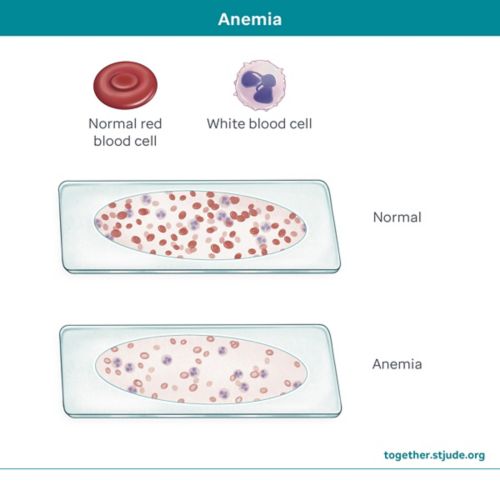What is an aplastic crisis?
An aplastic crisis happens when the bone marrow suddenly stops making red blood cells. When the body cannot make new red blood cells, it cannot replace the cells as they break down. Red blood cell counts can drop to very low levels. This can result in severe anemia.
Aplastic crisis mainly affects people with sickle cell disease, hereditary spherocytosis, or other similar blood disorder where the red cells are destroyed more rapidly (hemolytic anemia). In children with sickle cell disease and other hemolytic anemias, aplastic crisis is usually triggered by a parvovirus infection.
An aplastic crisis can cause severe anemia children with sickle cell disease and other hemolytic anemias. It can be life threatening if not treated right away.
Symptoms of aplastic crisis
Signs and symptoms of an aplastic crisis include:
- Feeling weak or tired
- Fever
- Cough
- Flu-like symptoms
- Shortness of breath
- Irregular or fast heartbeat
- Pale skin or lips
Without treatment, your child’s symptoms will likely get worse each day instead of better.
Causes of an aplastic crisis
An aplastic crisis is often triggered by an infection. One of the most common causes is human parvovirus B19 infection, or "fifth disease." This virus causes the bone marrow to stop making new red blood cells for 7–10 days.
An aplastic crisis is not a problem for most people because healthy red blood cells last 90-120 days. In people with sickle cell disease or other hemolytic anemias, red blood cells break down more easily. Sickled red blood cells may only last 7-20 days. If your child suddenly stops making new red blood cells, severe anemia can develop 1 to 2 weeks after the infection.
Once a child has had parvovirus, they rarely get it again. It is rare for an aplastic crisis to happen more than once.
Diagnosis of aplastic crisis
An aplastic crisis is diagnosed based on your child’s medical history, a physical exam, and lab tests. Lab tests may include:
Complete blood count (CBC)
A CBC test measures:
- The number of red blood cells, white blood cells, and platelets
- The size of red blood cells
- Hematocrit, which shows how much of the blood is made up of red blood cells
- Hemoglobin, a protein in your blood that carries oxygen
Red blood cells in people with sickle cell disease or other hemolytic anemias do not last as long in the body as normal red cells. As a result, hemoglobin levels can become dangerously low during an aplastic crisis.
Reticulocyte count
A reticulocyte count measures the number of young red blood cells in your child’s body. A reticulocyte is a new red blood cell that forms in the bone marrow. Normally, these cells stay in the bone marrow until they become mature red blood cells. Then they leave the bone marrow and go into the bloodstream.
A person with sickle cell disease or hemolytic anemia usually has a high reticulocyte count. But during an aplastic crisis, their reticulocyte count can go as low as zero.
Knowing your child’s CBC and reticulocyte counts lets your care team know how severe the anemia is. This helps them plan treatments. These counts may be checked every day during an aplastic crisis to monitor your child’s condition.
Testing for parvovirus
Blood tests can be done to diagnosis an active infection with parvovirus.
Treatment of an aplastic crisis
If your child has symptoms of aplastic crisis, seek medical care right away. Treatment of aplastic crisis may require a hospital stay for treatments and follow-up tests.
Your child might need a blood transfusion if they have severe anemia. During the transfusion, they will receive red blood cells from a donor. A transfusion of red blood cells will increase red blood cells and hemoglobin levels. This increases the blood’s ability to carry oxygen until the bone marrow is able to make new red blood cells again.
If your child has aplastic crisis due to parvovirus B19 infection, they will go into isolation during treatment. This means staying in a room away from other patients. People who enter your child’s room must wear a mask and a gown. This is needed because parvovirus B19 can spread from person to person. It is not dangerous to most people, but parvovirus can cause problems for other people with sickle cell disease, other hemolytic anemias, and pregnant women and unborn babies.
When to contact your care team
Call your care team if you think your child is in aplastic crisis. Your child needs treatment to avoid serious health problems, including death.
When to seek emergency care
Take your child to the emergency room right away if they have any of these symptoms:
- Trouble breathing
- Hard to wake up
- Looks very pale
- Acts very tired
Do not wait to talk to your care team if you see these signs. Go to the emergency room or call emergency services right away.
How to lower your child’s risk for aplastic anemia
Aplastic anemia is often caused by an infection with parvovirus B19. This virus is very common and spreads easily.
If your child has sickle cell disease or a similar blood disorder, take steps to prevent infection. Let your care team know if anyone in your family may have been exposed to someone with parvovirus or fifth disease.
Pregnant women should also stay away from a child with fifth disease or aplastic crisis. If a pregnant woman was near someone with parvovirus, she should tell her doctor right away. The virus can harm an unborn baby.
General steps to help prevent the spread of germs and infection include:
- Clean your hands often. Use soap and water or an alcohol-based hand sanitizer.
- Cover coughs and sneezes.
- Stay away from people who are sick.
- Avoid touching your eyes, nose, or mouth.
- Get vaccines that your care team recommends.
Questions to ask the care team

